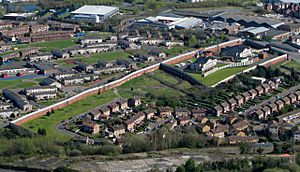Battle at Springmartin facts for kids
Quick facts for kids Battle at Springmartin |
||||||||
|---|---|---|---|---|---|---|---|---|
| Part of the Troubles and Operation Banner | ||||||||
 The interface area today. At the far end of the 18-foot (5.5 m) high peace wall is the former British Army base. The area has been extensively rebuilt since 1972. |
||||||||
|
||||||||
| Belligerents | ||||||||
| Strength | ||||||||
| 2 regiments | Unknown | Unknown | ||||||
| Casualties and losses | ||||||||
| 1 killed 1 wounded |
1 killed Unknown wounded |
1+ wounded 2 arrested |
||||||
The Battle at Springmartin was a series of intense gunfights that happened in Belfast, Northern Ireland. This event took place on May 13–14, 1972. It was a part of a difficult period known as The Troubles.
The fighting involved three main groups. These were the British Army, the Provisional Irish Republican Army (IRA), and the Ulster Volunteer Force (UVF). Seven people died during these battles. Five of them were regular people, called civilians. Four of these civilians were teenagers.
What Started the Fighting?

The violence began with a car bomb explosion. This bomb was set off by Ulster loyalists. It exploded outside a busy pub called Kelly's Bar. This pub was in Ballymurphy, an area where most people were Catholic and supported Irish nationalism.
The explosion happened around 5:00 PM on Saturday, May 13, 1972. The pub was full of people watching a football match. Sixty-three people were hurt, and eight were seriously injured. John Moran, a 19-year-old working at the pub, died later from his injuries.
After the bomb, UVF snipers started shooting. They fired from an empty building nearby. This building was in the Protestant Springmartin area. They shot at the people trying to escape the bombed pub.
At first, the British Army said the IRA caused the blast by accident. However, people in the area believed loyalists were responsible. It was later confirmed that loyalists had indeed planted the bomb. A memorial at the site remembers three staff members who died because of the bomb and the fighting that followed.
The Gun Battles Begin
The shooting started shortly after the bomb exploded. UVF gunmen had already taken positions in empty flats in Springmartin. These flats looked over the Catholic Ballymurphy area.
Tommy McIlroy, a 50-year-old Catholic civilian who worked at Kelly's Bar, was shot and killed. He was the first person to die in these battles. Ambulances had to drive through the gunfire to help the injured.
Members of the IRA quickly started shooting back. They tried to protect the injured civilians. British troops arrived at the scene and also exchanged gunfire with the IRA. Corporal Alan Buckley, a 22-year-old British soldier, was killed by the IRA. Another soldier was also hurt.
More British soldiers, about 300 of them, were sent to the area. For several hours, there were many shooting incidents. It was one of the most violent nights since the British government took direct control of Northern Ireland earlier that year.
The IRA fired at both the British Army and the UVF snipers. Much of their fire was aimed at the Henry Taggart Army base. This base was near the Springmartin flats.
Two more people died that night. Michael Magee, a 15-year-old, was found shot. He was a member of Fianna Éireann, an IRA youth group. He died soon after reaching the hospital. Robert McMullan, a 32-year-old Catholic civilian, was also shot near his home. Witnesses heard a single shot, and he fell. It is believed soldiers from the Henry Taggart base shot him.
That night, the police arrested two young UVF members. They were found trying to fix a jammed rifle. Police also found other weapons and ammunition.
Fighting Continues on Sunday
The gun battles between the IRA, UVF, and British Army started again the next day. British soldiers moved into the ground floor of the empty flats. UVF snipers continued to fire from the floors above them. Both groups were shooting into Ballymurphy.
There were also reports that some British soldiers did not stop UVF members. For example, a British Army patrol reportedly helped UVF members get into a timber yard. This yard overlooked the Catholic Ballymurphy area. When a British Army Major heard about this, he ordered his men to leave. However, the UVF members were allowed to stay in their position.
In the Springmartin area, a Protestant teenager named John Pedlow, 17, was killed by gunfire. His friend was also wounded. There are different accounts of who shot him. Some say soldiers did, while others say the IRA was responsible.
About three hours later, a 13-year-old Catholic girl named Martha Campbell was killed. She was walking along Springhill Avenue when a bullet hit her. She was with other young girls. Reliable loyalist sources say the UVF shot her.
Soon after, the loyalist Ulster Defence Association (UDA) set up roadblocks. They sealed off the Woodvale area. This created a "no-go" zone, meaning the UDA controlled who could enter or leave.
See also
- Chronology of Provisional Irish Republican Army actions (1970–1979)
- Timeline of Ulster Volunteer Force actions

